
Toxicodendron radicans, commonly known as eastern poison ivy or poison ivy, is an allergenic flowering plant that occurs in Asia and eastern North America. The species is well known for causing urushiol-induced contact dermatitis, an itchy, irritating, and sometimes painful rash, in most people who touch it. The rash is caused by urushiol, a clear liquid compound in the plant's sap. The species is variable in its appearance and habit, and despite its common name, it is not a true ivy (Hedera), but rather a member of the cashew and pistachio family (Anacardiaceae). T. radicans is commonly eaten by many animals and the seeds are consumed by birds, but poison ivy is most often thought of as an unwelcome weed. It is a different species from western poison ivy, T. rydbergii, which has similar effects.
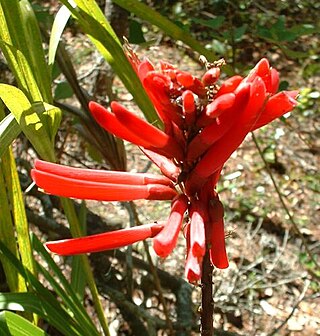
Erythrina herbacea, commonly known as the coral bean, Cherokee bean, Mamou plant in South Louisiana, red cardinal or cardinal spear, is a flowering shrub or small tree found throughout the southeastern United States and northeastern Mexico; it has also been reported from parts of Central America and, as an introduced species, from Pakistan. Various other systematic names have been used for this plant in the past, including Erythrina arborea, Erythrina hederifolia, Erythrina humilis, Erythrina rubicunda, Corallodendron herbaceum and Xyphanthus hederifolius.

Aralia spinosa, commonly known as devil's walking stick, is a woody species of plant in the genus Aralia of the family Araliaceae. It is native to eastern North America. The various names refer to the viciously sharp, spiny stems, petioles and even leaf midribs. It has also been known as Angelica-tree.
Afromorus mesozygia, known as black mulberry or African mulberry, is the only species in the genus Afromorus. The plant is a small- to medium-sized forest tree of Tropical Africa. Its leaves and fruit provide food for the mantled guereza, a colobus monkey native to much of Tropical Africa, and for the common chimpanzee of West and Central Africa. It is also a commercial hardwood.
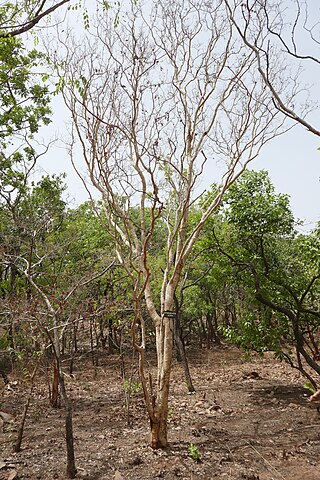
Hymenocardia acida is a plant of the family Phyllanthaceae native to tropical Africa. It is a small tree that grows to 10 m tall. Occurs in the Guinea and Sudanian savannah zones and deciduous woodland, from Senegal eastwards to Ethiopia and southwards reaching Zimbabwe.

Newtonia hildebrandtii, the Lebombo wattle, is a medium-sized tree native to eastern Africa. It is a protected tree in South Africa.

Myrianthus arboreus, the giant yellow mulberry or monkey fruit, is a dioecious tropical tree in the genus Myrianthus. It lives in the tropical Central African countries of Central African Republic, Gabon, Cameroon, Nigeria, and Tanzania. Its chromosome count is 2n = 28.
Ongokea is a genus of flowering plants, with one species Ongokea gore (Boleko). In the APG IV system, the genus is placed in the family Olacaceae. Other sources place it in the segregate family Aptandraceae.
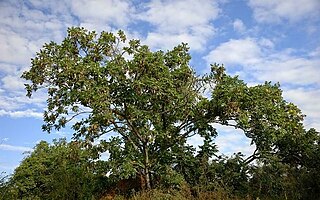
Aganope stuhlmannii is a deciduous tree within the family Fabaceae. It is native to tropical Africa and grows in savanna woodlands.

Pericopsis laxiflora is a woody deciduous shrub or tree within the Fabaceae family. Sold commercially as satin wood, it is known in some regions as Kulu Kulu, among the Hausa speaking people, it is called Makarfo, the Yorubas call it Ayan and the Igbos call it Abua-Ocha. It is one of three species in the genus Pericopsis genus that occurs in Africa.
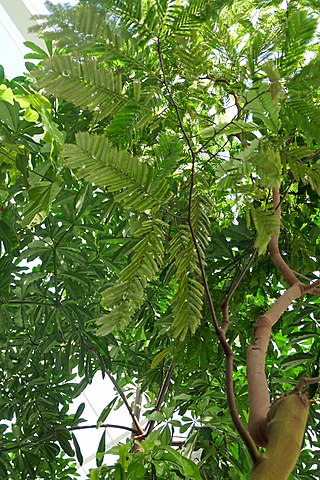
Piptadeniastrum africanum is a tall deciduous tree within the legume family, Fabaceae. It is native to the humid tropics of sub-Saharan Africa, ranging from Senegal to Sudan and Angola. It is the sole species in genus Piptadeniastrum. It is also called Piptadenia africana, and its timber is traded under the names Dabema or Dahoma. It commonly occurs in freshwater swamp forests but can also be found further north.
Landolphia buchananii is a liana within the Apocynaceae family. It is sometimes called Nandi rubber in English and known locally as Mugu among Kikuyus. Occurs in savannahs and montane forests in East Africa and Southeastern Nigeria.
Anthonotha macrophylla is a shrub to small understory tree within the family Fabaceae. It is endemic to the rain forest regions of West Africa and it is the most common of species within the Anthonotha genus in Africa.
Entandrophragma angolense, called the tiama, is a tree species with alternate, pinnately compound leaves that are clustered at the ends of branches. It is within the family Meliaceae and has a wide distribution area, occurring in moist semi-deciduous and evergreen forest regions of Tropical Africa from Sierra Leone to Uganda.
Thilachium africanum is a shrub or small tree within the family Capparaceae. It is found in Eastern and Southern Africa, from Kenya to Northeastern parts of South Africa and also in Madagascar
Zanthoxylum chalybeum is an aromatic deciduous shrub or tree within the family Rutaceae. It is also known as the lemon scented knobwood.
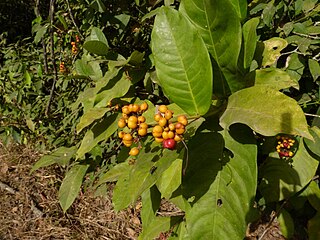
Ixora brachypoda is a species of shrub or small tree in the family Rubiaceae. It has fragrant flowers and glabrous leaves and stems.
Myrianthus holstii is a plant species within the family Urticaceae. It grows either as a shrub or tree. It is considered a dioecious species but a monoecious tree has been observed.

Ochna schweinfurthiana is a shrub or small tree belonging to the family Ochnaceae. It is represented in open deciduous woodlands in Tropical Africa.
Dupineta brazzae is a herbaceous species occurring in Tropical Africa, it belongs to the family Melastomataceae.










